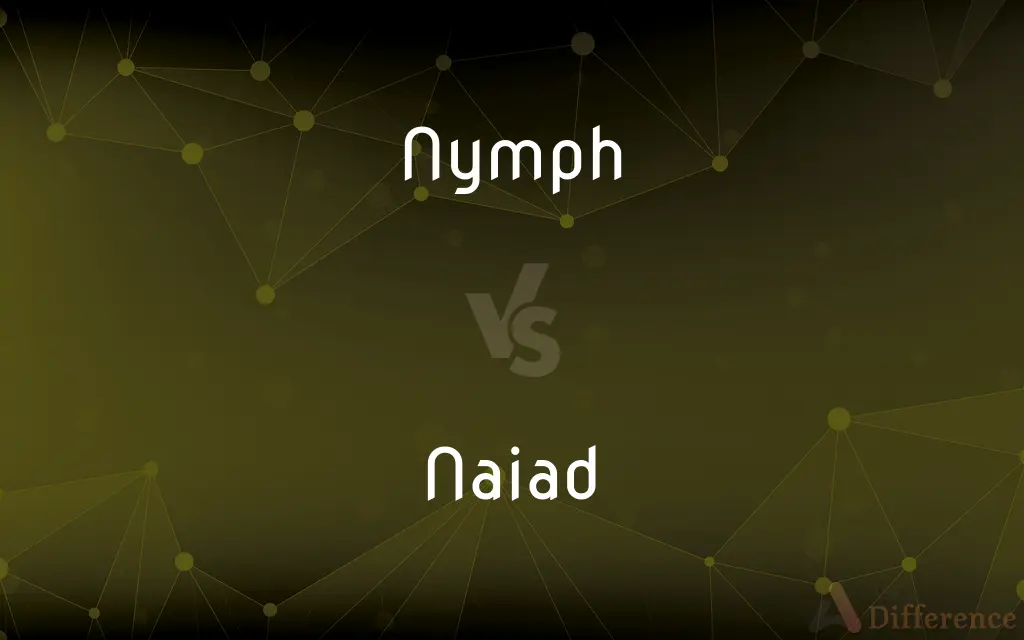Nymph vs. Naiad — What's the Difference?
By Fiza Rafique & Maham Liaqat — Updated on March 22, 2024
Nymphs are mythological spirits of nature, often depicted as beautiful young women associated with various natural elements. Naiads are a specific type of nymph in Greek mythology, associated exclusively with freshwater bodies.

Difference Between Nymph and Naiad
Table of Contents
ADVERTISEMENT
Key Differences
Nymphs in mythology embody the animate spirit of nature, taking various forms associated with elements like trees (dryads), mountains (oreads), and seas (nereids). Their roles span from nurturing wildlife to embodying the beauty and danger of nature. Naiads, as a subset of nymphs, specifically represent the spirits of freshwater sources such as rivers, springs, and lakes. This distinction highlights the specialization of naiads within the broader category of nymphs, focusing on their guardianship and embodiment of freshwater environments.
While all naiads are nymphs, not all nymphs are naiads, illustrating the hierarchical structure within mythological classifications. Naiads have a particular association with the life-giving and curative properties of fresh water, often featured in stories as protectors of their water bodies, healing or aiding heroes and mortals. In contrast, nymphs, in general, may have more diverse roles and associations, reflecting the broad spectrum of nature they embody, from fostering natural environments to interacting with gods and humans in various mythological narratives.
Nymphs and naiads share the common trait of being typically depicted as young and beautiful maidens, which is a reflection of the ancient Greeks' interpretation of the natural world's allure and vitality. However, the specific legends and myths surrounding naiads often emphasize their interaction with freshwater environments, such as the story of Hylas and the naiads, where the water nymphs are both enchanting and potentially dangerous to humans.
The reverence for naiads in ancient Greek culture is evidenced by the numerous shrines and rituals dedicated to these freshwater entities, reflecting their significance in daily life and spiritual beliefs. In comparison, the general veneration of nymphs underscores the broader ancient Greek appreciation for the natural world, its forces, and its spirits, illustrating the interconnectedness of mythology, religion, and the environment.
Comparison Chart
Definition
Mythological spirits of nature, often depicted as beautiful maidens.
A specific type of nymph associated with freshwater bodies like rivers and springs.
ADVERTISEMENT
Association
Trees, mountains, seas, and various elements of nature.
Exclusively with freshwater environments.
Roles
Protecting nature, interacting with gods and humans.
Guarding freshwater sources, often involved in healing or enchanting mortals.
Mythological Hierarchy
Broad category encompassing various types of nature spirits.
A subset of nymphs specifically focused on freshwater.
Cultural Significance
Represent the vitality and capriciousness of nature.
Symbolize the life-giving and sacred aspects of fresh water.
Compare with Definitions
Nymph
Guardians of the natural world, often interacting with gods and humans in mythology.
Nymphs were said to attend to Artemis, the goddess of the hunt and wilderness.
Naiad
Considered protectors of their water realms, often associated with healing properties.
Ill travelers sought the blessings of naiads, hoping for curative waters.
Nymph
Symbols of fertility and growth in ancient cultures.
Agricultural festivals often invoked the blessings of nymphs for bountiful harvests.
Naiad
Worshipped in specific rituals and ceremonies, emphasizing the sacredness of fresh water.
Ancient Greeks held ceremonies at naiad sanctuaries to ensure the purity of their water sources.
Nymph
Representations of the beauty and danger inherent in nature.
Sailors revered the sea nymphs, fearing their ability to stir the oceans into storms.
Naiad
A type of nymph that presides over freshwater sources, such as rivers, springs, and lakes.
The naiads of the local spring were honored with offerings for clean water.
Nymph
Central figures in many myths and legends, embodying the interconnectedness of nature and the divine.
Echo was a nymph cursed never to speak first but to only repeat what others said.
Naiad
Featured in myths involving love and tragedy, reflecting the dual nature of water as life-giving and dangerous.
The myth of Hylas, who was pulled into the water by enamored naiads, warns of their mesmerizing allure.
Nymph
A spirit of nature depicted as a beautiful maiden, associated with natural elements.
The dryads, nymphs of the trees, whispered in the forest winds.
Naiad
Symbols of the essential and nurturing aspects of water in the environment.
Naiads were revered as the sustainers of life, vital for both communities and natural ecosystems.
Nymph
A mythological spirit of nature imagined as a beautiful maiden inhabiting rivers, woods, or other locations
The idyllic world of nymphs and shepherds
A wood nymph
Naiad
In Greek mythology, the naiads (; Greek: Ναϊάδες, translit. naïádes) are a type of female spirit, or nymph, presiding over fountains, wells, springs, streams, brooks and other bodies of fresh water.
Nymph
A nymph (Greek: νύμφη, nýmphē; Ancient: [nýmpʰɛː], Modern: [nímfi]) in ancient Greek folklore is a minor female nature deity. Different from Greek goddesses, nymphs are generally regarded as personifications of nature, are typically tied to a specific place or landform, and are usually depicted as beautiful maidens.
Naiad
(in classical mythology) a water nymph said to inhabit a river, spring, or waterfall.
Nymph
An immature form of an insect that does not change greatly as it grows, e.g. a dragonfly, mayfly, or locust.
Naiad
The aquatic larva or nymph of a dragonfly, mayfly, or stonefly.
Nymph
A mainly brown butterfly that frequents woods and forest glades.
Naiad
A submerged aquatic plant with narrow leaves and minute flowers.
Nymph
Greek & Roman Mythology Any of numerous minor deities represented as beautiful maidens inhabiting and sometimes personifying features of nature such as trees, waters, and mountains.
Naiad
Greek Mythology One of the nymphs who lived in and presided over brooks, springs, and fountains.
Nymph
The eight-legged immature form of certain arachnids, such as ticks and mites.
Naiad
The aquatic nymph of certain insects, such as a mayfly, damselfly, or dragonfly.
Nymph
Any female nature spirit associated with water, forests, grotto, wind, etc.
Naiad
Any of various aquatic plants of the genus Najas.
Nymph
A young girl, especially one who is attractive, beautiful or graceful.
Naiad
(Greek mythology) A female deity (nymph) associated with water, especially a spring, stream, or other fresh water.
Nymph
(entomology) The larva of certain insects.
Naiad
(entomology) The aquatic larva (nymph) of a dragonfly or damselfly.
Nymph
(entomology) Any of various butterflies of the family Nymphalidae.
Naiad
Any of various aquatic plants of the genus Najas.
Nymph
A goddess of the mountains, forests, meadows, or waters.
Where were ye, nymphs, when the remorseless deepClosed o'er the head of your loved Lycidas?
Naiad
A water nymph; one of the lower female divinities, fabled to preside over some body of fresh water, as a lake, river, brook, or fountain.
Nymph
A lovely young girl; a maiden; a damsel.
Nymph, in thy orisonsBe all my sins remembered.
Naiad
Any species of a tribe (Naiades) of freshwater bivalves, including Unio, Anodonta, and numerous allied genera; a river mussel.
Nymph
The pupa of an insect; a chrysalis.
Naiad
One of a group of butterflies. See Nymph.
Nymph
Any one of a subfamily (Najades) of butterflies including the purples, the fritillaries, the peacock butterfly, etc.; - called also naiad.
Naiad
Any plant of the order Naiadaceæ, such as eelgrass, pondweed, etc.
Nymph
(classical mythology) a minor nature goddess usually depicted as a beautiful maiden;
The ancient Greeks believed that nymphs inhabited forests and bodies of water
Naiad
Submerged aquatic plant having narrow leaves and small flowers; of fresh or brackish water
Nymph
A larva of an insect with incomplete metamorphosis (as the dragonfly or mayfly)
Naiad
(Greek mythology) a nymph of lakes and springs and rivers and fountains
Nymph
A voluptuously beautiful young woman
Common Curiosities
Can naiads leave their water bodies?
Mythology often portrays naiads as closely tied to their water sources, though they may venture out for brief periods.
How were naiads and other nymphs worshipped in ancient times?
They were honored with rituals, offerings, and dedications at natural sites, reflecting their importance in daily life and spirituality.
Are naiads exclusive to Greek mythology?
While naiads are specifically from Greek mythology, similar water spirits appear in various cultures' mythologies.
Are there modern interpretations or representations of naiads and nymphs?
Yes, naiads and nymphs frequently appear in modern literature, art, and media, symbolizing nature's beauty, mystery, and power.
Do naiads interact with other types of nymphs?
Yes, myths sometimes depict naiads interacting with other nymphs and deities, reflecting the interconnectedness of natural elements.
Are there male nymphs or naiads?
Nymphs and naiads are typically depicted as female, embodying the ancient Greek ideals of beauty and fertility associated with nature.
Can naiads and nymphs be considered gods or goddesses?
They are considered lesser deities or spirits, embodying aspects of nature rather than ruling over domains like Olympian gods and goddesses.
Do naiads have any known weaknesses or enemies?
Myths rarely mention specific weaknesses, but like many mythological beings, they can be susceptible to the actions of gods, heroes, and mortals.
How do naiads influence ecosystems, according to myths?
They are believed to maintain the health and purity of freshwater ecosystems, crucial for the survival of both natural and human communities
What distinguishes naiads from mermaids or sirens?
Naiads are freshwater spirits and do not possess fish tails, unlike mermaids. Sirens, originally bird-women, later depicted as mermaid-like creatures, are specifically known for their dangerous songs.
Share Your Discovery

Previous Comparison
Department vs. School
Next Comparison
Elegy vs. LamentAuthor Spotlight
Written by
Fiza RafiqueFiza Rafique is a skilled content writer at AskDifference.com, where she meticulously refines and enhances written pieces. Drawing from her vast editorial expertise, Fiza ensures clarity, accuracy, and precision in every article. Passionate about language, she continually seeks to elevate the quality of content for readers worldwide.
Co-written by
Maham Liaqat















































